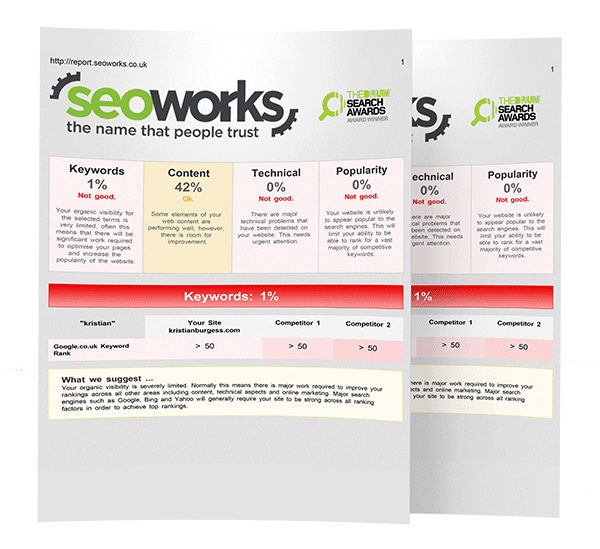Semantic SEO: What is it? And How to Use it
Search engines have transformed significantly over the past decade. In the early days, Google would simply scan web content for keywords in order to match users with results.
Now, Google has a much more accurate understanding of the true meanings behind search queries and content – interpreting user intent, search behaviour and context more accurately than ever before.
This is all thanks to semantics, an area of linguistics and natural language processing (NLP) concerned with the meanings of language.
Semantic search is concerned with understanding the meaning of web-based information and search queries more accurately, with the ultimate aim of processing language and information in the same way a human could.
Semantic SEO is the process of building more meaning and relevance into web content, providing topical breadth and depth to help search engines understand your content more accurately.
This article explains the importance of semantic search and how it can be used in SEO for better results.
Semantic SEO at a glance
Here’s a quick overview of everything we’ll cover in this article:
- What is semantic SEO?
- Why semantic SEO is important
- What is semantic search?
- Google’s semantic search algorithms
- How to use semantic SEO
- Keyword research for semantic SEO
- SERP analysis
- Writing content for semantic SEO
- Technical considerations
- Internal linking considerations
What is semantic SEO?
Semantic SEO is the practice of creating more meaningful and relevant web content around particular topics.
This goes beyond simply answering a search query with a direct response. Semantic SEO investigates the value beyond what is said in the query by focusing on meanings and topics, rather than keywords.
A semantic approach connects entities, terms, and subtopics together across your site in order to provide more value, depth and relevance to a particular subject.
This is done by creating a network of semantically related content, organising information in a meaningful way to form semantic links between pages.
The purpose of semantic SEO is to answer user intent more accurately, taking into account information beyond the search query itself that would provide potential value to the user. Additionally, this helps demonstrate topical authority to search engines.
Semantic SEO approaches can involve creating comprehensive guides that cover topics in detail – answering the first question, followed by answers to subsequent questions that enrich the topic with more breadth and depth.
The process also involves creating topical clusters, whereby a topic and its subtopics are covered in detail across a series of interlinked pages.
Why is semantic SEO important?
Search engines are getting better and better at understanding language in the same way humans can – and this is largely due to semantic Natural Language Processing (NLP) technology.
This makes a linguistic approach to SEO more important than ever, especially as Google makes further advancements with semantic-based NLP search algorithms, such as MUM.
Google’s increasingly semantic-based search algorithms are concerned with understanding the meanings of web content with more accuracy.
And if Google is continuously understanding web content in more detail, we must consider how to build more meaning into web content with semantic SEO.
The benefits of semantic SEO
As Google continues to improve its semantic understanding of language, a semantic SEO approach is more important than ever.
There are a number of benefits to semantic SEO strategies, from earning higher rankings to providing users with more valuable information.
Here are some of the main benefits of semantic SEO.
1. Rank higher
The most obvious benefit of semantic SEO is that your site will be more likely to rank higher than pages that are less relevant to the search query.
Google’s semantic search algorithms measure topical authority to determine the perceived quality of your website, affecting the site’s ability to rank.
2. Earn featured snippets
To extract featured snippet information, Google uses semantic analysis to identify the most meaningful and valuable sections of web content. Thus, in order to earn featured snippets, you have to consider building more meaning into your content with a semantic approach.
3. Develop industry authority
By covering relevant topics in more breadth and depth, you are demonstrating your position as an authoritative voice in your industry. Not only to search engines, but also to users.
4. Provide more value for users
We are increasingly relying on search engines to provide the information we need, whenever we need it.
Users expect quick and accurate search results, with the option to find out more if necessary – and semantic SEO is the best way to meet this need.
5. Have fun exploring topics
Last but not least, semantic SEO can be a lot of fun! Whether you are an SEO, marketer, or business owner, exploring a topic in depth can be genuinely interesting and help you learn useful (or sometimes, useless) pieces of information.
What is the difference between SEO and semantic SEO?
SEO (Search Engine Optimization) focuses on optimizing websites to improve visibility in search engine results through keyword optimization and traditional techniques, while Semantic SEO is an advanced approach that emphasizes understanding the context and intent behind user search queries. Semantic SEO utilizes semantic technologies like natural language processing and machine learning to enhance the understanding of content, consider the relationship between words and concepts, and deliver more relevant search results based on user intent rather than just keywords.
What is semantic search?
Semantic search is the process by which search engines generate results that match the intended and possible meanings of a search query, rather than results that simply match the keywords.
At a most basic level, semantics can be applied to words themselves, drawing on the meanings of individual terms. Semantics can also be observed at broader levels, for instance, how context can affect the meaning of search queries.
Semantic search models are necessary for search engines to figure out what exactly the searcher is looking for, but also provide value beyond this.
Semantic search engines interpret queries alongside a number of contextual factors to better understand the meaning and intent. This includes:
- Query context and location
- User search history
- The relationship between words in the search query
- The relationship between similar searches
These considerations mirror the semantic cues we use in everyday conversation to understand what is being said.
This is Google’s exact aim; to facilitate a search engine capable of advanced Natural Language Processing that can interpret complex linguistic cues.
For example, the word ‘run’ could mean several things depending on what is being said:
- The act of physically running (‘I am running’)
- Quickly departing from somewhere (‘I have to run’)
In everyday conversation, we’d typically understand the meaning by drawing on the context and surrounding words.
As semantic search technology advances, search engine result pages (SERPs) are becoming increasingly accurate; rich with valuable information that helps us answer our questions with fewer searches.
Semantic SEO and Natural Language Processing (NLP)
Natural Language Processing (NLP) is an area of computational linguistics. NLP enables computer programs and search engines to understand human language in both spoken and written forms.
NLP models encompass a broad range of linguistic aspects such as syntax, morphology and phonology, but rely heavily on semantic processes in order to make computers understand language meanings in context.
Google’s search uses artificial intelligence NLP systems to process language. As an artificial intelligence model, Google’s NLP systems not only understand language, but continuously learn more about language as time progresses.
Google’s semantic search algorithms
Google has been on a long journey in order to establish its semantic search capabilities. Let’s take a look at how Google’s search got to where it is today.
The Knowledge Graph (2012)
Google introduced the Knowledge Graph in 2012, which is essentially a massive database of public information.
This database allowed Google to begin connecting entities together, forming an understanding of the relationship between different things, people, places, movies, works of art and countless other pieces of information.
You’ll see Google’s Knowledge Graph in action almost any time you conduct a celebrity search, with a panel of information that details their birthdate, marital status, spouse, featured movies, fellow cast members and more.
Hummingbird (2013)
Google released Hummingbird in 2013. This saw the emergence of semantic search techniques, using NLP to match results with the meaning of search queries, rather than with keywords.
This saw pages with more context-rich information perform better than pages lacking substantial context around keywords, and even rank without containing the exact keyword.
Rankbrain (2015)
Rankbrain was introduced by Google in 2015 as a machine learning AI system. Similar to Hummingbird, Rankbrain aimed to improve Google’s semantic understanding of language.
The major difference between the two is that Rankbrain uses machine learning artificial intelligence, which continuously analyses top organic search results and establishes similarities between useful pages.
BERT (2019)
Google’s BERT, short for Bidirectional Encoder Representations from Transformers, was introduced in 2019.
BERT saw a major advancement in Google’s ability to accurately depict search intent and deliver more accurate results. This update helped Google account for more complex and conversational search queries, opening up more opportunities for pages to rank for longtail search queries.
MUM (2022)
Google’s 2022 MUM update uses an AI-based system to help users find answers to their queries with fewer searches.
It can sometimes take several searches to get the information we are looking for, but MUM aims to deliver meaningful results much faster by understanding complex queries more accurately.
MUM can search for answers across web pages regardless of language, and can even understand information from non-text entities, such as images. This allows Google to surface relevant subtopics that offer more context and depth around particular subjects.
How to use semantic SEO for better rankings
The development of semantic search has changed the world of SEO forever.
Instead of focusing on keywords, sites now need to take a more holistic approach to SEO that considers topical relevance and user value.
Here’s how to get started with semantic SEO.
1. Keyword research for semantic SEO
When completing keyword research for semantic SEO, the most important thing to remember is that you are targeting topics, not keywords.
You should start with a broad topic in mind, and then plan more specific subtopics to target in relation to your main subject.
Start with traditional methods of keyword research to identify broader search queries, and then follow by researching more specific keywords.
Your topics can then be mapped hierarchically, with broader topics taking precedence over more specific topics. It is still useful to consider factors such as search volume here.
Tools you can use to research keywords include:
Keyword variations and synonyms
When carrying out your keyword research, it’s important to consider keyword variations.
These are similar keywords that variate from your target term in some way. Keyword variations can look nearly identical if they use synonymous terms, for instance ‘how to make a blog’ vs ‘how to create a blog’.
It is important to take a look at the search results for such keyword variations, as this will give you an idea of whether they are semantically related.
You will likely find that the search results are identical, even though both search terms are formed differently – this is because Google understands that, semantically, they share the same meaning under the same topic.
For example, the keywords ‘feeding my dog’ and ‘what should my dog eat’ generate nearly identical results on Google, despite being worded differently.
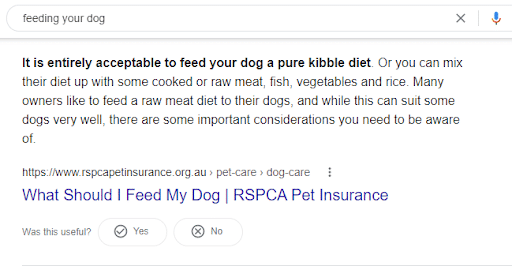
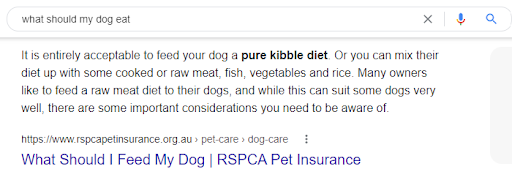
Including keyword variations in your content can be semantically useful. Keyword variations can help you:
- Avoid keyword stuffing and repetition.
- Expand the semantic core of your content by referencing more than one search option for your target topic.
2. Extract semantic information from Google SERPS
Semantic SEO approaches are concerned with building topical relevance across your site content.
But, how do you identify topically relevant information?
To understand more about your topic, analyse the SERP (search engine results page) features that appear for your target term.
SERP features
SERP features provide an impression of the kinds of subtopics, themes and similar searches that relate to your chosen topic.
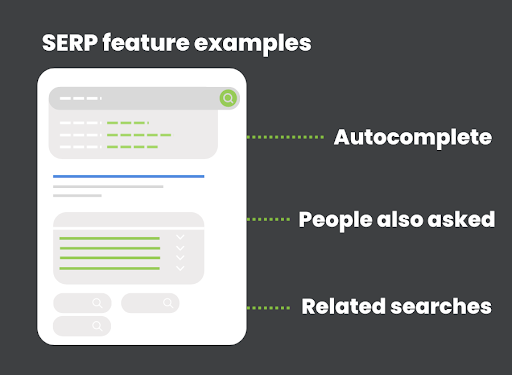
This is semantically relevant information that provides insight into how Google understands your chosen topic.
SERP features can therefore be used to extract semantic data from Google. This information can be found across the following SERP features:
- ‘People also ask’ questions
- Related searches and suggested queries
- Query refinement filters
- Rich results, such as images
- Google knowledge panels
- Google autocomplete
SERP analysis will help you identify ways of covering your topic in more depth and form a comprehensive semantic SEO strategy.
There are several online tools that can help you gather information from SERP features, such as:
- Answer The Public – provides Google autocomplete data around your keyword
- Also Asked – provides live, geo-specific ‘people also ask’ data around your keyword
Search intent
Search intent is one of the most important things to consider in semantic SEO. This refers to the meaning behind a search query and aims to understand what exactly the searcher is looking for.
Users might be searching for information around a subject, searching for a product or service, or even searching to complete a transaction.
Use the top SERP results to assess how Google is interpreting the search intent. For instance, if top-performing pages are mostly informational, you will need to create an informational piece in order to rank.
3. Writing content for semantic SEO
In SEO, planning content used to be a matter of creating pages for keywords with the most promising search volumes.
Now, it’s essential to consider how your content will fit into the overall semantic structure of your site.
Having selected your target keywords, and pulling semantic information from SERPs, it’s time to start thinking about how exactly you’ll target topics and semantically related subtopics.
It’s important to consider whether you should target topics broadly or more specifically.
Comprehensive content
For broader topics, the likelihood is that top-performing pages cover the subject using broad and comprehensive content.
This is usually one large piece of content that incorporates the main topic and semantically related subtopics into one comprehensive piece – for example, an ‘ultimate guide’ or ‘complete guide’.
Comprehensive content will usually include information from SERP features, such as subtopics from ‘people also ask’ questions and suggested queries.
Topic clusters
Topic clusters cover a topic and wide range of subtopics across a series of interlinked pages.
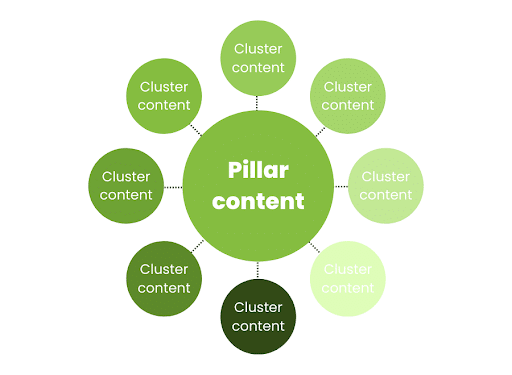
Remember, just because you find semantically relevant information in the search results doesn’t mean that you should include all of that together in one long piece of content.
Semantically related subtopics can be targeted on individual pages and still provide breadth and depth to the semantic structure of your site.
These pages should be internally linked to and from one another, and most importantly, to the main topic piece.
Topic clustering fulfils the aims of semantic SEO by building more meaning and topical relevance across your site.
4. Consider contextual factors
Search engines will look at contextual factors such as location and the user’s previous search history to understand a search query’s meaning more accurately.
Many of these methods mimic the way we understand meanings in everyday conversation. For instance, if I were to ask you “where is the town hall?”, and then asked “how far away is it?”, you would understand that ‘it’ refers to the town hall.
Additionally, you’d know how far away the town hall was based on the speaker’s location (given you knew your way around town, of course).
Search engines apply similar semantic analyses to derive meaning, taking a look at a user’s previous searches and locational factors to provide the most relevant results.
This is something to consider if you provide a local service. If users are searching for your service using location-based terms, such as ‘phone repairs near me’, you can provide more contextually relevant information using location service pages. For instance, a page for ‘phone repairs in Sheffield’.
If users are searching for your service in nearby locations, you can provide relevant results by creating location pages.
Technical semantic SEO considerations
Semantic SEO strategies mostly relate to content, however there are also technical SEO considerations to make that can help improve your site’s semantic offering.
The following technical considerations can help with semantic SEO:
- Implement structured data – Structured data is designed to give search engines and users more context to your page. Google uses structured data for rich snippets, knowledge graphs and other SERP features.
- Optimise alt text – Alt text is used to provide image descriptions for the visually impaired. Not only is this essential for accessibility purposes, alt text can also provide more context for search engines.
Internal linking and semantic SEO
One of the most important aspects of semantic SEO is internal linking.
Internal links are used to help users easily navigate across pages of your site, but are also used by search engine bots to crawl related pages.
Internally linking can therefore help build semantic connections between different pages on your site, indicating which themes are topically related.
Here are some useful internal linking tips to consider in your semantic SEO strategy:
- Internally link content cluster pages – Topical clusters are extremely useful for building more meaning into your site. But, it’s just as important to internally link these pages to and from one another to indicate their relevance.
- Use descriptive anchor text – Anchor text is the piece of text used to take users to the linked page. This should be specific and indicate what the linked page covers.
In the HTML, anchor text looks like this:
<a href=”https://www.example.com”>example anchor text</a>
Avoid using generic anchor text like ‘click here’. Instead, use natural language that provides relevance to users. For example ‘content writing tips’ linking to a page about content writing tips.
Summary
A semantic SEO approach is truly the way forward in SEO, and has been for some time now.
With the development of semantic search engines, there needs to be a holistic effort that considers the site’s overall topical offering and semantic structure.
Although the concepts behind semantic search may seem complex, the semantic SEO process itself is not.
Many of the approaches to semantic SEO replicate the intuitive ways we use language in real life.
When we ask a question, we expect a response – but the conversation doesn’t end there. We might have more to ask, more to find out, or another related question.
Semantic search aims to replicate this natural language style, and semantic SEO aims to facilitate it.

Jacob has a background in linguistics and digital language, with a keen interest in all things content!
